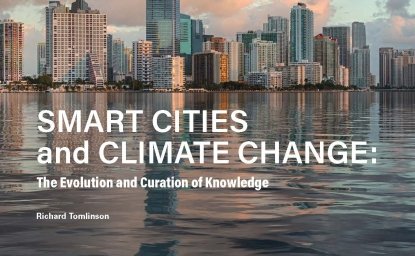Water for Big Cities: Big Problems, Easy Solutions?

Presented February 8-9, 1999, at the Woodrow Wilson Center for the Comparative Urban Studies Project's Research Working Group on Urbanization, Population, the Environment, and Security funded by the U.S. Agency for International Development. These policy briefs do not represent an official position of the Woodrow Wilson International Center for Scholars or the U.S. Agency for International Development. Opinions expressed are solely those of the authors.
The Magnitude of the Problem
In large urban area of developing countries, about 30% of the population does not have access to safe water, and 50% does not have adequate sanitation. That means that over 500 million people do not have safe water, and 850 million people do not have proper sanitation. By the year 2020, there will be nearly 2 billion more people in urban areas needing these services. Putting it another way, in the next 20 years water supply coverage will have to more than triple, and sanitation coverage more than quadruple, if everyone in these countries is to be adequately served. To do this, even at a low consumption figure of 100 liters/person/day, will require an additional 88 BCM/year - both of water to be supplied and of wastewater to be safely disposed of.
Considering capital costs alone, this would imply investments of US $24 billion each year from now until 2020. These costs, however, are small compared with those for providing conventional wastewater disposal, which would require an additional US $82.5 billion/year. Compared to current levels of spending (around US $20 - 25 billion/year, of which multilateral lending accounts for around US $1 billion/year), approximately a fourfold increase would be needed.
Examining these rough estimates, one can easily understand the expressions of alarm emanating from professionals in the sector.
However, even if funds of this magnitude were available, most of the existing sector institutions would not be able to make effective use of them. This is partially because the sector institutions in developing countries have almost invariably been modeled on those in industrialized countries, with a top-down supply-based approach, and little if any understanding or skills in involving the community in ensuring sustainable supply. However, another problem that is at least as severe is political control of the sector, which result in institutions that have limited autonomy, and so suffer from gross over-staffing, inability to offer competitive employment conditions that would attract and retain competent staff, and lack of authority to set tariffs that recover costs and provide a sound basis for proper operation, maintenance and system expansion.
Three Easy Remedies
Certainly there are some countries, and some cities, where absolute scarcity of water will make life extraordinarily hard unless growth can be curbed and over-exploitation and pollution of water resources halted. But in the great majority of cases there are remedies at hand which should have been forcefully applied years ago. It is still not too late to apply them, but time is running out.
These remedies are:
(a) Reduce unaccounted-for water (water that is pumped into the system but never produces any revenues for the company), which at present is often at an excessively high level
(b) Avoid or discourage wasteful use, by imposing higher charges on excessive use, encouraging the use of water-efficient fixtures or industrial processes, and, above all, adopting sanitation systems that place minimal demands on water supply.
(c) Change inter-sectoral water allocations, in particular from inefficient, low-value irrigation usage to higher-value, higher-efficiency urban supply.
Reduction in unaccounted-for water
Many cities do not know what happens to more than half of the water that is pumped into their systems. This water disappears through physical leaks, is stolen through illegal connections, is not recorded because meters are not functioning or are not read, or is not billed because of institutional inefficiency or corruption. The proportions vary according to each individual case, but the impact is the same: a system that is very hard to manage, where scarce water is lost, and which does not generate enough revenue to support proper operation and maintenance. A system that has only 15% unaccounted-for water sells 85% of its product, while one with 50% unaccounted-for water sells 50% of its product; put another way, if the two systems had the same production capacity the first one would have 70% more sales volume than the second.
The ways to solve this problem are well-known and not technically complicated. They are:
· Reduce physical losses to the lowest level economically feasible
· Meter at least all major consumers (universal metering may have to be a longer-term project)
· Bill everyone for water supplied, and enforce payment.
Why these have not been rigorously applied by "water-short" cities, or insisted upon by multilateral donors, is one of the mysteries of the sector; the current levels of losses would not be tolerated in a commercial operation.
Avoid or discourage wasteful use
Just as the tools to reduce unaccounted-for water are well known, so are many of the tools for reducing unnecessary use of water.
· Tariffs should increase with increasing consumption. Low-income users need to be protected by "lifeline" rates, but the higher levels of consumption should be charged at the marginal cost of developing new supplies (which is what excessive use will eventually force); this is likely to be two or three times higher than the cost of current supplies, and should act as a deterrent to frivolous use.
· Water-saving devices should be mandatory, so that all new installations and all renovations use only such devices. Flush toilets in particular, which can account for 40% of domestic use, must be made more efficient (with a 6-liter flush as an upper limit).
· Industrial processes should be made much more water-efficient, either by process redesign or by recycling within the industry itself (where industries are permitted to develop their own supplies, independently of municipal systems, those abstractions need to be licensed and resource depletion fees imposed).
· Alternative on-site sanitation systems offer the same health benefits as conventional sewerage, at a fraction of the cost, and require little or no water for operation. Where sewers are needed, simpler, less expensive alternatives to conventional systems can provide the same level of service. Since most "waterborne": diseases in fact have their origin in faecal-oral transmission due to inadequate sanitation, policy endorsement and widespread adoption of these alternative sanitation systems is one of the most significant single contributions that could be made to water conservation and public health.
Change inter-sectoral water allocations
Although water use in urban areas may be inefficient, the losses are lower, and the cost recovery better, than the equivalent use in irrigated agriculture. Also, municipal use makes up a relatively small proportion of total water use, while agriculture may account for 70 - 80 per cent. Therefore, if water is to be treated as an economic good, it is reasonable to consider reallocating water from irrigation to municipal use. The impact on agricultural production need not be severe (10 per cent increase in agricultural efficiency could meet all municipal demands, worldwide), and the marginal value in use of water in agriculture is lower, by perhaps a factor of 10, than the willingness of urban households to pay for it. A small increase in the fees charged for irrigation water (or introduction of such fees, in the many cases where water is supplied without charge) should release sufficient water resources to meet anticipated urban deficits.
Of course, this is a politically sensitive issue, and it is probably unreasonable to consider it until the institutions responsible for urban water supply have clearly demonstrated, by undertaking the other two steps successfully, that they are using water as efficiently as possible, but still suffer shortfalls. They are then justified in insisting on water resource reallocations; after all, water used in food production can in effect be imported (in the form of the food itself, for example, grain), but it is not feasible to import the water needed to sustain a city.
One questionable "solution"
The current conventional thinking on the part of the MFIs (multilateral financing institutions) is that municipal water supply should be provided through private sector intervention. There is no doubt that private sector participation has much to offer in terms of better management skills and a more commercial approach. However, this solution needs to be examined carefully before being recommended as a panacea, as it raises some serious issues, for example:
· What are the implications of handing over a "natural monopoly" to a commercially-oriented private sector company, especially (as seems to be the case at present) if this company is foreign?
· Can such a company be expected to ensure affordable service to the urban poor? If it is required to do so under the terms of its agreement with the municipality, does the regulatory capacity exist to enforce such behavior?
· Are the limited number of companies internationally involved in this privatization effort able to provide the services demanded?
And, the most fundamental of all:
· Given the preparatory effort required, and the relaxation of existing constraints essential to ensure success of the privatization, could the same result have been achieved as efficiently by empowering local sector institutions to operate under the new commercial rules, with the same degree of external assistance?
Why the "Easy Solutions" have not been implemented?
The list of reasons why these apparently easy solutions have not been implemented is long, and highly dependent on individual circumstances. It includes
· Commissioning major new source and transmission works is politically far more rewarding than the mundane task of reducing unaccounted-for water. It is also much easier to obtain external funding for new works, and the MFIs have not made unaccounted-for water reduction a precondition of funding for new investments.
· Water supply has not been treated as a commercial enterprise. Keeping water tariffs low can be presented as controlling inflation or making service affordable to the poor (in reality, it ensures service deficiencies such that the poor never get supplied and have to pay very high rates to vendors). Raising tariffs, on the other hand, can result in riots, especially if it has to be done before service can be improved.
· Service standards are too often based on inherited inappropriate codes, leading to unaffordable, non-sustainable systems, rather than ones permitting progressive upgrading over time to match people's changed economic circumstances. This is especially so in sanitation.
· Inadequate community consultation, leading to supply-driven rather than demand-driven projects, and hence to poor cost recovery because of failure to determine "effective demand".
· Failure to create effective institutional frameworks, including regulatory capacity, autonomous service providers, appropriate involvement of the private sector and the user communities.
· Lack of integrated water resources management (which would include the use of "linear" rather than "circular" systems, so as to extract the maximum value from all resources used, and taking a holistic view, treating water and sanitation systems as interdependent).
Conclusions
Governments (in collaboration with External Support Agencies, where these are involved) need to determine which of the "easy solutions" are appropriate, and then implement them. However, it is abundantly clear that this will not have the desired effect in the absence of political will and an "enabling environment". Government (at all levels, national, regional or state) therefore needs to support the institutions responsible for service delivery in taking the necessary actions to establish such an environment. These actions include:
· Developing an integrated approach to all water resources use, and creating institutions that will be able to resolve inter-sectoral and inter-regional conflicts over use.
· Creating a structural and regulatory framework that (a) devolves responsibility for urban environmental service delivery to the lowest level able to provide it; (b) encourages private sector participation and community participation; and (c) supports community management of service delivery where the community is able and willing to assume that responsibility.
· Ensuring that urban environmental services are sustainable over the long term.
· Exploring ventures with the private sector to reduce the need for publicly -funded capital investment programs and to increase institutional competence.
· Clarifying the relationships between the technology for wastewater and its impact on water demand (including exploring the issue from the ecological perspective of nutrient-cycling ).

Urban Sustainability Laboratory
Since 1991, the Urban Sustainability Laboratory has advanced solutions to urban challenges—such as poverty, exclusion, insecurity, and environmental degradation—by promoting evidence-based research to support sustainable, equitable and peaceful cities. Read more

Explore More
Browse Insights & Analysis
Dr. Maurice Jackson: The Sounds of Resistance Throughout History

Smart Cities and Climate Change: The Evolution and Curation of Knowledge

